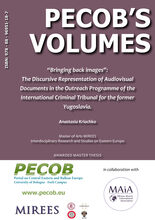and Balkan Europe
by IECOB & AIS Università di Bologna

This area collects and offers a wide range of scientific contributions and provides scholars, researchers and specialists with publishing opportunities for their research results
“Bringing back images”: The Discursive Representation of Audiovisual Documents in the Outreach Programme of the International Criminal Tribunal for the former Yugoslavia
by: Anastasia Kriachko
pp: 103
ISBN: 978-88-96951-18-7
In collaboration with:
MIREES Alumni International Association (MAiA)

Abstract
Audiovisual documents have become a pivotal part of every aspect of the International Criminal Tribunal for the former Yugoslavia daily work. Still, there is little information about how these audiovisual documents are used in order to justify the moral impact of the ICTY on citizens in the region. This thesis seeks to address this gap in the literature. Audiovisual documents promote a better understanding of the functionality of the institutions of transitional justice in the advancement of the rule of law. The use of these documents allows international tribunals not only to dispense justice, but also establish a historical record. Apart from analyzing the development of audiovisual documentation by the ICTY (through its Outreach Programme), this thesis traces the reactions of the general public in Serbia to the efforts of local non-governmental organisations and the ICTY itself to spread the knowledge about the work of transitional justice in the region through the use of audiovisual documents. The research does not seek to establish its own truth or confirm one of the multiple and conflicting truths surrounding the conflict and the break-up of Yugoslavia. Rather, it analyses the ways in which the past is represented by the ICTY in its documentaries, and displayed through public events, such as the conferences organised by the ICTY.
The thesis develops a unique theoretical approach inspired by the disciplines of transitional justice, media, and audiovisual studies. The theoretical approach emphasises the discursive representation of audiovisual documents produced and disseminated by the ICTY. Furthermore, it traces the visual images of the conflict in former Yugoslavia and the impact these images have had on the audience. This theoretical approach forms the basis of the method employed in this thesis, analytically separated in three parts. First, it investigates the actual narrative portrayed in the audiovisual documents, including all linguistic denotations and sentences that may create real-world effects. Second, the method identifies the context in which this narrative is conveyed, which is used by the filmmakers to create a specific effect. Third, the method allows for analysing the intertextuality of the audiovisual document, namely, the sequences of events that occur after the documentary is distributed to the public. This is done to establish the points of divergence and convergence between the audiences’ and the documentaries’ conceptualizations of truth about specific war crimes. Apart from relying on a range of secondary sources, I have conducted interviews with filmmakers and producers of the documentaries, as well as representatives of Serbian non-governmental organisations involved in publicising the activities of the ICTY locally.
The analysis conducted in this thesis reveals that the ICTY, through its Outreach Programme, has established itself as a conveyor of truth in the region, and Serbia, in particular. The truth about war crimes, presented as being proved “beyond reasonable doubt”, is being continuously highlighted in the documentary film materials of the ICTY. The ICTY film production reaches the audiences using the mainstreaming methods, similar to that of regular movies. The messages conveyed in the documentaries often clash with the hegemonic views on war crimes in Serbia, failing to make a significant impact on a wider section of the population. Nevertheless, I shall argue that these visual materials and the way they are presented have a potential of closing the gap between the currently competing discourses on war crimes in the region.
Keywords
Audiovisual documents, transitional justice, ICTY, Outreach Programme, Serbia
Table of contents
List of abbreviations
Abstract
Keywords
Introduction
Literature review
1.1 No one is forgotten, nothing is forgotten… How do scholars interpret the Balkans’ way of dealing with the past?
1.2. Transitional justice: the ICTY and its Outreach Programme
1.2.1 The Outreach Programme
1.3 Audiovisual documents in transitional justice
Theory & methodology
2.1 Theory. Audiovisual documents in transitional justice
2.2 Theory: The discourse and intertextuality of audiovisual documents
2.2.1 The discursiveness of audiovisual documents
2.2.2 The intertextuality of audiovisual documents
2.3 Methodological approach. Research design
2.4 Assessing reliability and validity
Analyses. Documentaries and conferences
3.1 Documentaries of the Outreach Programme
3.1.1 Establishing ICTY as a conveyer of truth
3.1.2 ‘Mainstreaming’ transitional justice
3.1.3 Outreach: informing wider audience
3.2 Series of Conferences “Beyond reasonable doubt”: Čelebići, Foča, Brčko, Prijedor, Srebrenica
3.2.1 Conferences reiterate the documentaries’ mission. Establishing ICTY as a conveyer of truth
3.2.2 Conferences reiterate the documentaries’ mission. Outreach: informing wider audience
3.2.3 Establishing dialogue about wartime
3.3 Clashes of truth: the Outreach Programme and its audience
3.3.1 Outreach Programme’s filmmakers about the documentaries
3.3.2 Clashes of truth. The involvement of the Outreach Programme
Conclusions
Bibliography
Author’s Biography
PECOB’S VOLUME: SELECTED MIREES MASTER THESES
The initiative of:
University of Bologna, Vytautas Magnus at Kaunas, Corvinus of Budapest and St. Petersburg State University, together with University of Ljubljana and University of Zagreb
In collaboration with:
MIREES Alumni International Association (MAiA)
Institute for Central-Eastern and Balkan Europe (IECOB)
Selection coordinated by:
MIREES Faculty Academic Council
Editorial coordination by:
Prof. Francesco Privitera, MIREES Programme Director
Adriano Remiddi, President of the MAiA Executive Board
Giovanni Cadioli, MAiA Editorial Manager
Luciana Moretti, IECOB Editorial Assistant


 Download the Thesis
Download the Thesis





